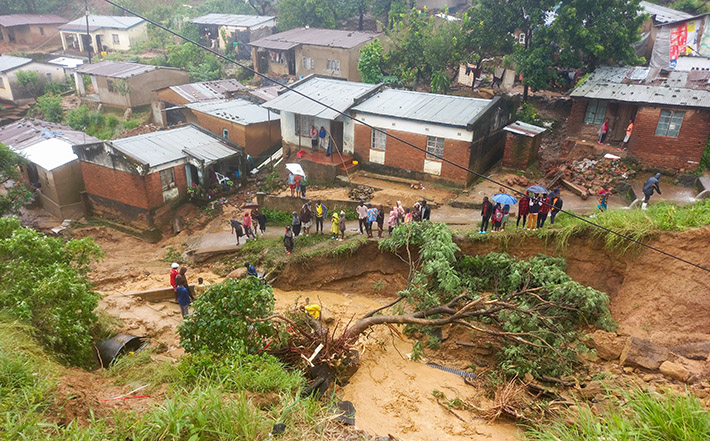|
||||||||||
| Home Nation World Business Opinion Lifestyle ChinAfrica Multimedia Columnists Documents Special Reports |
|
||||||||||
| Home Nation World Business Opinion Lifestyle ChinAfrica Multimedia Columnists Documents Special Reports |
| ChinAfrica |
| For a Green Future |
| Why Africa should get a fair climate change funding regime without a debt trap |
| By Mahasha Rampedi | VOL. 15 November 2023 ·2023-11-14 |

The Africa Climate Summit 2023 is held in Nairobi, capital of Kenya, on 4 September
In the summer of 2022, subtropical storm Issa pounded parts of the KwaZulu-Natal Province in South Africa, claiming 459 lives. It displaced more than 40,000 people and caused 36 billion rand ($1.92 billion) worth of infrastructure damage.
Issa-related floods and landslides swept away bridges and more than 4,000 homes, mainly in the coastal city of Durban and the surrounding areas. Researchers from Wits University in Johannesburg and the University of Brighton in the UK called the floods the “most catastrophic natural disaster” ever recorded in KwaZulu-Natal. They also attributed them to global warming.
In February 2023, cyclone Freddy devastated Southeast Africa, killing at least 522 people and leaving a trail of destruction in Mozambique, Malawi and Madagascar. Malawi was the hardest hit, with no fewer than 300,000 people affected in that country alone. According to the World Meteorological Organisation, cyclone Freddy was probably the longest ever in recorded history.
In North Africa, more than 4,000 people were killed, and over 46,000 were displaced when storm Daniel devastated the central Mediterranean in September this year. Two dams collapsed in Libya and flooded the coastal city of Derna in the country’s east, causing untold suffering.
These are just some of the latest cases of the high price Africa continues to pay for climate change despite contributing the least to global warming compared to the developed nations. Developed countries, particularly those in North America, Europe and Asia, have historically been the largest emitters of greenhouse gases like carbon dioxide, methane and nitrous oxide. These emissions primarily come from industrial activities, transportation and energy production. In contrast, many African nations have lower levels of industrialisation and transportation infrastructure.
Unrealistic approach
Drought, floods and storms affect Africa more than the biggest polluters, and it will get worse.
According to the United Nations Convention to Combat Desertification, Africa accounts for 44 percent of all severe droughts recorded globally in the past century and, in the last five decades, sustained economic losses of more than $70 billion alongside incalculable human suffering. It added that droughts aggravated by climate change and land degradation may affect three in four people globally by 2050.
In this context, African leaders held the maiden Africa Climate Summit in Nairobi, Kenya, in September 2023. The regional climate meeting was a precursor to the 28th session of the Conference of the Parties to the UN Framework Convention on Climate Change in the United Arab Emirates in November this year. It brought together policymakers, government officials, scientists, the private sector and communities to discuss ways to better manage the world’s land and environment for the planet’s sustainability.
The Africa Climate Summit resulted in the adoption of the Nairobi Declaration. It called for strategic investments in sustainable land and water management to reduce future droughts. Moreover, the declaration called for drought resilience mechanisms and growth patterns that align the economic development of developing nations with their unwavering commitment to climate change.
However, the adopted declaration will unlikely deal with the challenges brought about by climate change in Africa and realise green development. It is out of touch with reality on the ground, lacks innovation, and absolves the developed nations as historical polluters from their shared responsibility towards sustainable climate solutions.
For starters, in 2009, the developed nations, mainly Group of Seven members, pledged to raise their combined contribution to $100 billion per year by 2020 to support climate responses in developing nations, the majority of which are in Africa. This promise has not been fulfilled.
Instead, they opted to offer the developing nations loans rather than grants to fight climate change. This strategy has resulted in African nations devastated by global warming being trapped in perpetual debt while trying to clean the mess left by the developed countries.
Take, for example, South Africa. The US, Britain, Germany and France offered Africa’s most advanced economy $8.5 billion in financing. As part of the deal, the country is required to prematurely decommission its coal-fired power stations in favour of green energy despite being one of the world’s top coal producers. The bulk of the funding consists of loans at concessional rates, with a fraction allocated as grants, which makes no sense at all.

People gather in an area damaged in floods in Blantyre, Malawi, on 14 March
Sharing the burden
Climate financing should be a shared responsibility that considers historical facts and pollution levels by the developed nations. Africa needs a new climate finance regime that allows the developed countries to fund the developing nations without trapping them in debt. In this case, the developed nations should fund Africa’s gradual transition from fossil fuel to green energy without further complicating their existing debts and threatening their sovereignty.
Back to the cyclones and storms which devastated Southeast Africa and Libya this year, most of the affected countries had no early warning systems because of a lack of meteorological infrastructure. The residents of Derna in Libya, for instance, said they were not warned in advance about the floods expected from storm Daniel so that they could evacuate. The same can be said about the residents of Malawi and Mozambique.
Moreover, the Africa Climate Summit declaration does not seem to contain a clear plan to migrate from coal energy to green energy while protecting the environment. In other words, the declaration parroted Western strategies to fight global warming without considering local conditions and budget constraints.
By focusing on drought resilience measures and linking economic development to commitment to climate change, the Nairobi Declaration ignores local conditions in Africa. Agriculture, tourism and mining are the economic backbones in most parts of the continent. If farmers are only taught about drought resilience strategies, what happens when floods hit without any early warning? Their crops and livestock would be washed away by floods, which would perpetuate poverty levels. Without reliable meteorological data, they won’t know what and when to plant.
So, Africa can easily fight climate change by uniting behind a common vision that pushes for common but differentiate responsibilities between themselves and the developed nations. They should demand unconditional climate funding from the developed nations, and gradually transition from fossil fuels without being rushed and sleepwalked into a debt trap.
The author is Editor-in-Chief of Africa Times
| About Us | Contact Us | Advertise with Us | Subscribe |
| Copyright Beijing Review All rights reserved 京ICP备08005356号-5 京公网安备110102005860号 |